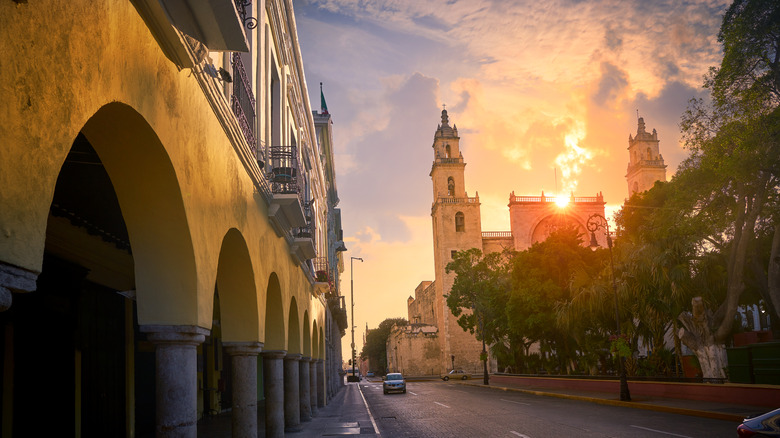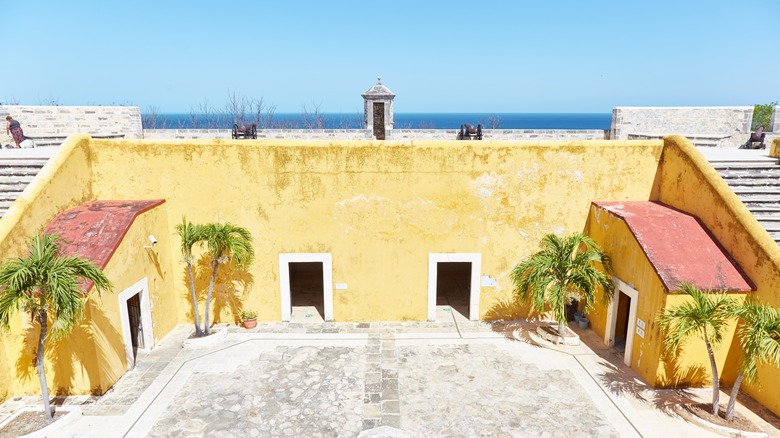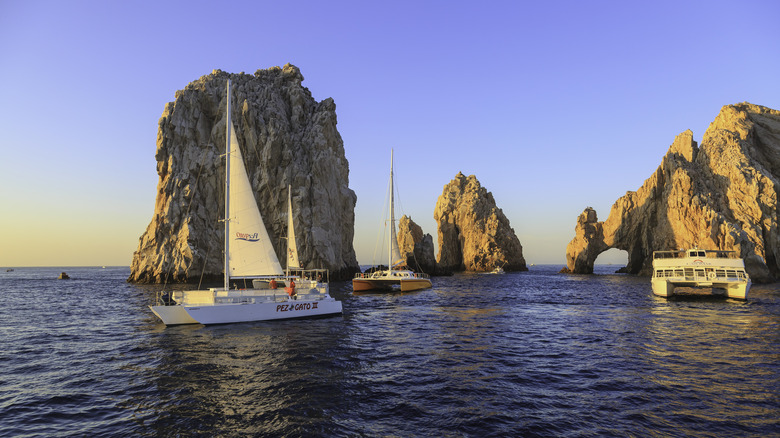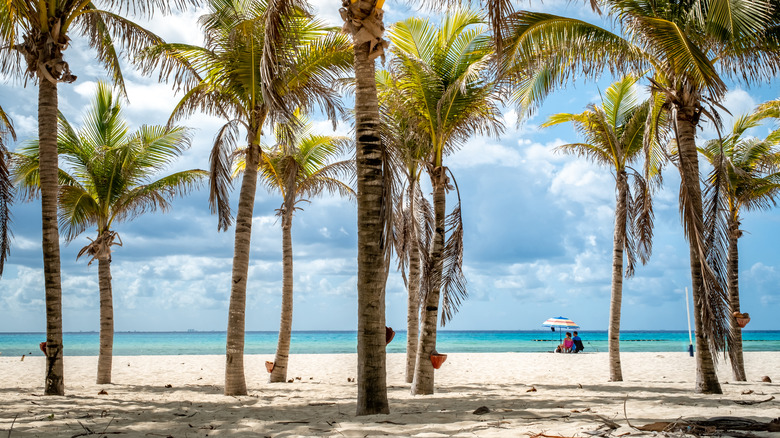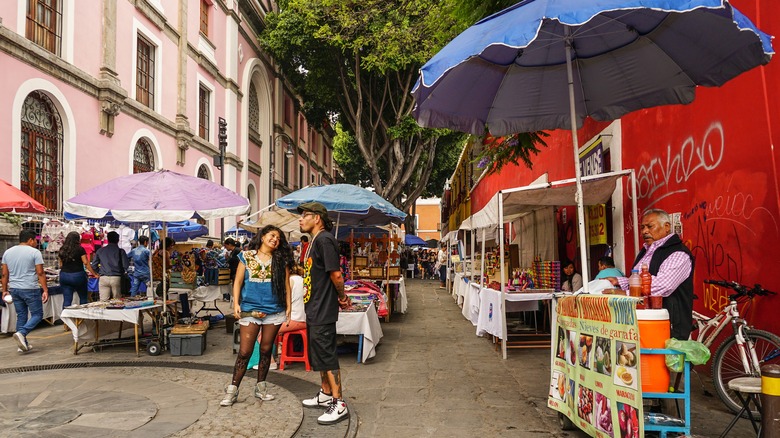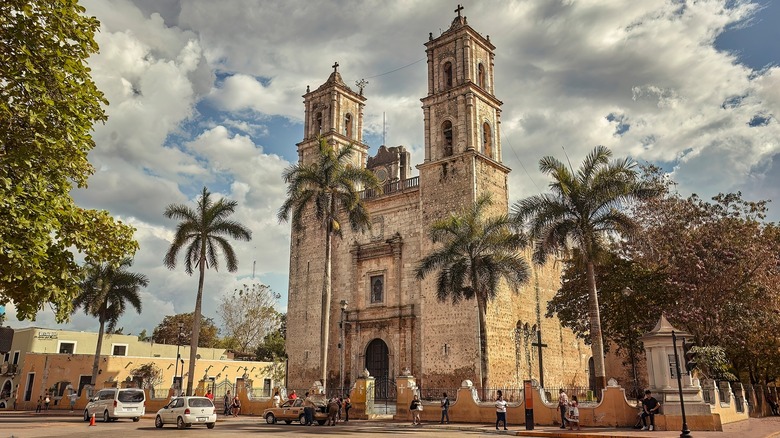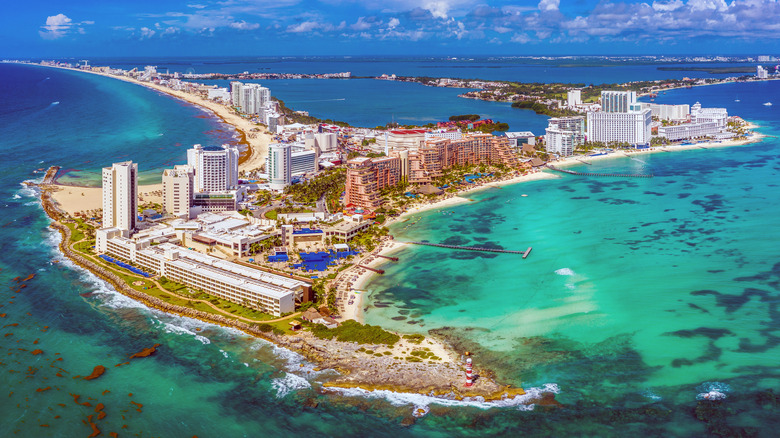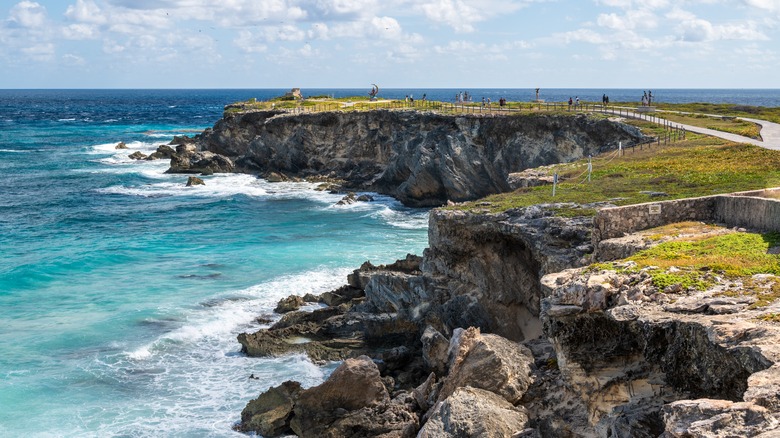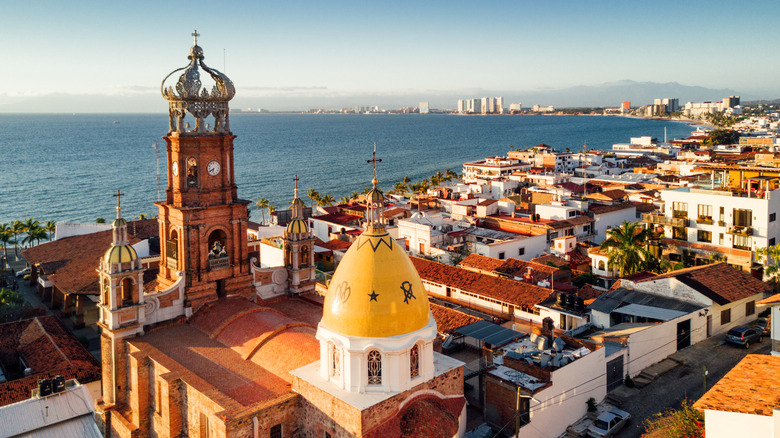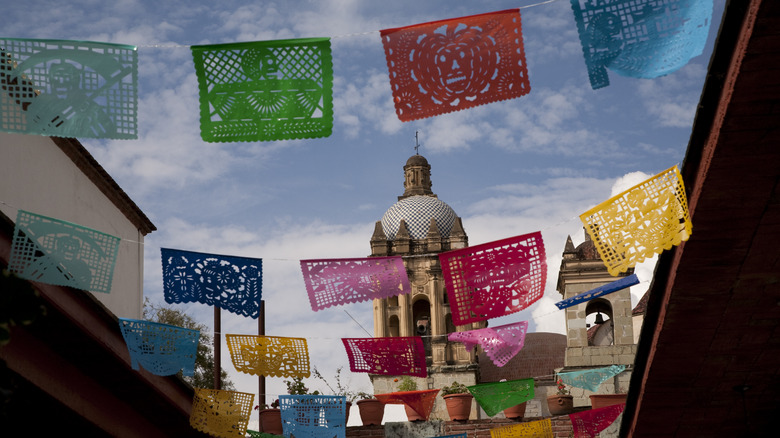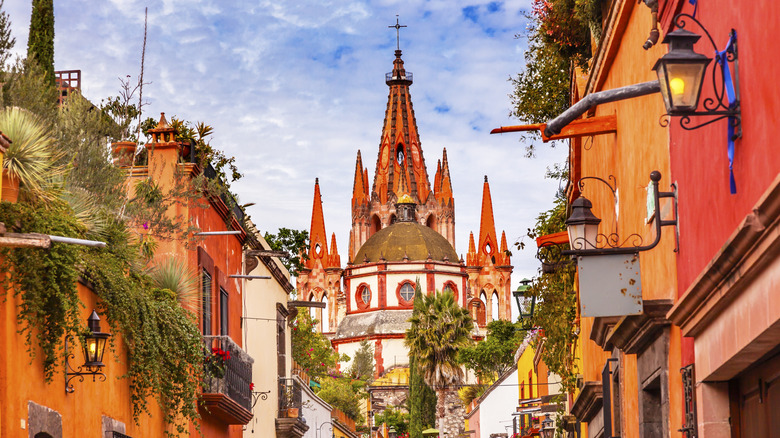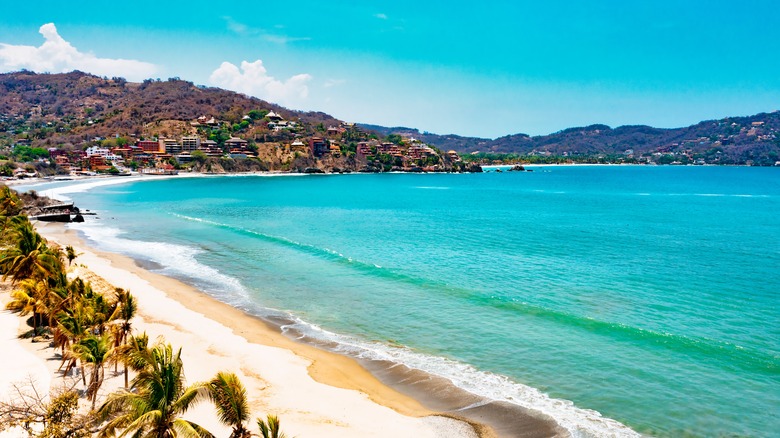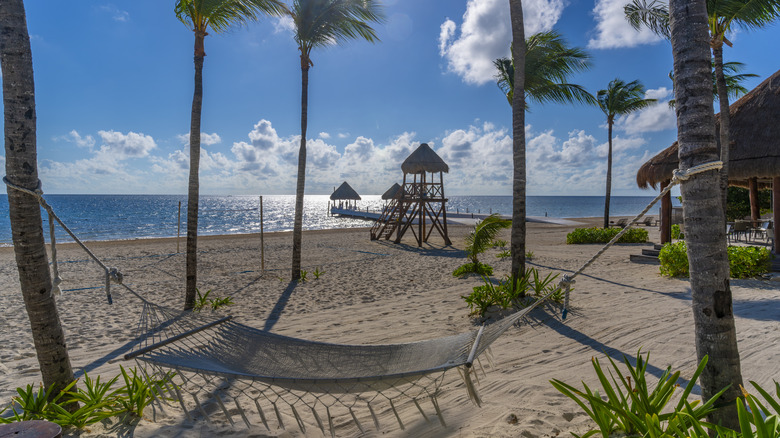The Safest Destinations In Mexico For A Stress-Free Vacation, According To Research
The myriad charms of Mexico offer something for every vacationer. Many of the nation's diverse destinations provide opportunities to enjoy laidback coastal paradises, amazing archaeological monuments, world-class cuisine, fascinating contemporary art, and luxurious accommodations. In numerous places across Mexico, several of these attractions can be experienced within a single day.
Unfortunately, some regions of this thrilling nation are not considered safe for travelers. The regrettable reality of cartel-related crime primarily affects Mexican citizens, but it may impact international visitors as well. Low-level lawbreakers who target tourists can quickly transform a vacation into an ordeal; no matter where they occur, minor crimes create major hassles for victims simply trying to enjoy themselves during their hard-earned time off.
Fear not — we've uncovered a diverse range of the most secure destinations for a vacation in Mexico by carrying out in-depth research of recent crime statistics provided by the Mexican government's DataMéxico website, along with advisories from the U.S. Department of State (U.S. DOS), travel-insurance company recommendations, and trusted media sources, all augmented by personal experiences of traveling throughout this gorgeous country. While crime can occur anywhere you go, and this article is not intended to address safety concerns related to natural disasters or similarly unpredictable hazards, the following hotspots across Mexico are recommended by travel experts as safe destinations for stress-free vacations.
Mérida
Yucatán is one of only two states in Mexico that the U.S. DOS considers as level-one "Exercise Normal Precautions" destinations. Mérida is Yucatán's peaceful capital, packed full of relaxing attractions, all within a central location providing easy access to ancient Mayan sites like Chichén Itzá and Uxmal. While this is not a waterfront city, Mérida is near some of Mexico's best Gulf Coast beaches, adding to the appeal of an extended visit here.
According to DataMéxico, Mérida's overall crime levels have dropped considerably over the past decade, making this one of the nation's safest cities. Here, vacationers can enjoy carefree walks at any time of day along the leafy Paseo de Montejo, lined by grand 19th-century mansions, welcoming cafes, and stylish boutiques. At the boulevard's northern end, the massive Monumento a la Patria sculpture depicts scenes spanning hundreds of years in Mexican history.
Mérida's other must-see spots include the San Ildefonso Cathedral — one of the New World's oldest monumental churches, completed in 1598. There is also the pleasantly bustling Plaza Grande, which hosts a Sunday market featuring goods by regional artisans. Best of all, Mérida is a convenient hub for numerous attractions across the upper Yucatán Peninsula, making it an ideal base for discovering varied Mexican splendors.
San Francisco de Campeche
Campeche is the other Mexican state boasting a U.S. DOS level-one ranking, and its primary city has ample experience in providing security. You only need to check out its imposing coastal fortifications, built here in the late 1600s to repel pirates and other invaders, as evidence of this. These well-preserved strongholds are a major reason why the historic center of San Francisco de Campeche earned UNESCO World Heritage status.
The past year has seen a remarkable decrease in criminal incidents reported by DataMéxico for the state of Campeche. AXA Travel Insurance recommends San Francisco de Campeche as one of Mexico's safest destinations, praising recently increased municipal law enforcement efforts. These security endeavors make exploring this city a breeze, from its multi-colored colonial buildings to the enchanting Mayan Culture Museum housed within the Fort of San Miguel, which displays artifacts like jade ornaments and ceramic figurines.
In the vicinity of San Francisco de Campeche, several sandy beaches and magnificent ancient ruins add to the appeal of this city often considered an off-the-beaten-path destination ... but it likely won't stay that way for long. In December of 2023, the newly-built Maya Train railway launched a service connecting Campeche with the global tourism magnet of Cancún — so it's probably a good idea to discover this Gulf Coast gem before too many other visitors do the same. You won't regret it.
Los Cabos
While the U.S. DOS classifies Baja California Sur as a level-two "Exercise Increased Caution" state, according to the United Kingdom's Foreign, Commonwealth and Development Office, Los Cabos is a heavily protected tourism zone. The longtime leisure hotspot of Cabo San Lucas "can be an extremely safe destination for anyone looking for a sun-and-fun getaway," as stated by Berkshire Hathaway Travel Protection. Statistics provided by DataMéxico indicate that Los Cabos crime rates have remained fairly stable over the past decade, with the majority of incidents relating to stolen property. On that note, Berkshire Hathaway recommends being careful with your valuables and utilizing hacks that will protect you from pickpockets while traveling. However, as Cabo San Lucas expands its collection of luxury resorts, the tourism industry is working with local law enforcement to provide round-the-clock security and constant monitoring of visitor hangouts.
With that in mind, visitors who take ordinary travel safety precautions can relax and enjoy the many vacation amenities offered around Los Cabos, from whale-watching excursions to lush golf courses to long expanses of picturesque beaches. One caveat about those sandy shores: Be extremely careful around the ocean waters surrounding this region, as strong waves can be deadly in the popular beach vacation spots of Cabo San Lucas.
Playa del Carmen
Comprising the Caribbean-facing eastern side of Mexico's Yucatán Peninsula, the state of Quintana Roo has level-two U.S. DOS classification — but the beachfront resorts, artistic attractions, and bustling nightlife spots of Playa del Carmen are protected by a specialized police force dedicated to safeguarding tourists, according to the AEGIS Travel Insurance Division. Moreover, local authorities are renewing efforts to improve security in this centerpiece community of the Riviera Maya. This enhanced law enforcement is likely a response to gradually rising crime rates reported throughout Quintana Roo by DataMéxico, with incidents of theft and property damage topping the total complaints.
As Quintana Roo's economy is skyrocketing — largely due to its growing tourism industry — it only makes sense that state officials are devoting significant resources to ensure the safety of visitors across the region. As a result, Playa del Carmen vacationers can expect easygoing days of snorkeling at a sparkling array of nearby coral reefs, admiring intriguing murals, and checking out the diverse shops, restaurants, and nightclubs lining La Quinta Avenida, a miles-long pedestrian lane. While some vendors along this stretch can get a little aggressive with their sales techniques, you can always refuse them with a firm "no, gracias."
Puebla
Tucked amid the mountains between Mexico City and Veracruz, Puebla is a hidden gem of colonial architecture and fantastic cuisine. Recommended as one of Mexico's safest cities by the Vigilios travel-security app, Puebla features captivating museums and traditional markets overflowing with colorful regional produce. The city also has many well-preserved historic buildings dating back hundreds of years, earning this destination a spot on the UNESCO World Heritage list.
The surrounding state of Puebla has a U.S. DOS level-two rating, but there are no restrictions barring government employees from visiting its namesake city. According to DataMéxico, crime rates have remained remarkably steady over recent years in the municipality of Puebla, with approximately 45% of reported complaints involving stolen property. While this statistic may be a good reason to purchase a budget-friendly lock to prevent worrying about theft while traveling, Puebla's much lower rates of violent crime are certainly reassuring for potential visitors.
Once there, vacationers will discover that Puebla is a feast for the senses — especially the sense of taste. Several iconic Mexican dishes are said to have originated in Puebla, including chile rellenos, cemita sandwiches, and sopa poblano, a vegetable soup enlivened with roasted chili peppers. Don't forget to pack the appetite.
Valladolid
Often relegated to a quick photo-op stop for tour buses taking day-trippers from Cancún to Chichén Itzá, Valladolid deserves a second look. This relatively small but beautiful town features a wealth of authentic cultural attractions, from eye-catching art galleries to diverse religious landmarks to live music and dance performances held in the main square almost every evening. There is plenty of substance behind the style here.
Safety is also an excellent reason to plan a vacation in Valladolid. This is another municipality located within the Yucatán state — classed with the coveted level-one U.S. DOS rating — and AXA Travel Insurance includes Valladolid among its selection of Mexico's most secure destinations, noting that visitors "may see uniformed police officers patrolling several areas of the city, deterring criminals." Additionally, Valladolid's crime statistics presented by DataMéxico have remained consistently low for years.
Though it's fairly far from any coast, Valladolid is close to a wide range of regional attractions. The list includes the lesser-known Mayan ruin sites of Ek Balam and Cobá, as well as sacred cenote sinkholes where visitors can swim. This is also a central base for visits to prominent Yucatán Peninsula destinations — it typically takes under two hours to drive from Valladolid to Mérida, Cancún, or Tulum.
Cancún
With a population of close to a million, the entire city of Cancún was seemingly built to provide international visitors with sun-soaked memories. Until the early '70s, this modern-day waterfront metropolis for pleasure seekers was merely a tiny Caribbean fishing village — and then the Mexican government rapidly transformed Cancún's barrier island into a row of massive resorts. Just like that, an enormous tourism-based economy was constructed.
Naturally (or as naturally as any planned megacity can be), the Mexican authorities have ample reason to keep Cancún safe for visitors and their vacation dollars. However, criminals also like money, and this is reflected by the dutiful divulgence of DataMéxico, revealing that a wide range of crime statistics have continuously risen in Cancún since 2016. Being a city within level two Quintana Roo, the U.S. DOS specifically advises Cancún visitors to be especially careful after dark and remain in tourist areas.
But since money talks — and is fluent in Spanish — Cancún authorities are stepping up crime-fighting capacities with the installation of high-tech monitoring devices. Berkshire Hathaway Travel Protection adds that most of the community's homicides occur between locals, insisting that "Cancún is still safer than cities like Minneapolis, Indianapolis, and Portland, Oregon." While this may be somewhat reassuring, Berkshire Hathaway also advises visitors to consider staying at Cancún's all-inclusive resorts with comprehensive private security. Luckily, Cancún has plenty of excellent all-inclusive resorts to choose from.
Isla Mujeres
If the huge hotels of Cancún can't provide the Caribbean idyll you seek, catch the ferryboat to nearby Isla Mujeres, a slender island with a laid-back spirit and plenty of peaceful accommodations perfect for leaving the world behind. Removed from the city action, this sleepy destination has very low crime rates compared to bigger tourism hubs. According to DataMéxico (during May 2024), a total of 34 criminal complaints were reported across Isla Mujeres. During the same month, 2,463 such complaints were filed in Cancún. So, while Isla Mujeres is also within the state of Quintana Roo (and thus is technically a U.S. DOS level-two destination), by the numbers, a vacation on this lesser-visited isle should be a much safer bet.
Unfortunately, Isla Mujeres visitors will miss out on the ample nightlife action that awaits in Cancún. Instead, they can discover local restaurants serving high-quality cuisine, an undersea art gallery of sculptures for snorkelers, and the sandy expanse of Playa Norte, a palm-lined beach perfect for lazy days of sunbathing and people-watching. Rent a golf cart, and all of Isla Mujeres is at your disposal, including Punta Sur — the easternmost point in Mexico, where the ruins of a small Mayan temple still stand.
Puerto Vallarta
Overall, Jalisco state is regarded as a Level 3 "Reconsider Travel To" destination by the U.S. DOS — yet its bayside retreat of Puerto Vallarta remains almost entirely removed from the cartel-related crime that takes place far inland. For this reason, the State Department imposes no restrictions on U.S. government employees to prevent them from visiting this charming coastal community full of spirited cultural draws. Crime does occur in Puerto Vallarta. However, according to DataMéxico, most statistics have stayed low and steady over the past decade. The biggest change regarded reports of stolen property, which dropped dramatically in 2019, and theft numbers have remained diminished since then.
For the vast majority of Puerto Vallarta visitors who will encounter no nefarious incidents, this balmy city offers mellow days of strolling the waterfront Malecon and admiring its open-air performances and art galleries. After beachgoers enjoy spectacular sunsets, the Zona Romantica comes alive with its wide selection of restaurants and nightlife spots. Sweetening this scenario for travelers of all orientations, the AEGIS Travel Insurance Division states that Puerto Vallarta is an especially safe Mexico beach-city hotspot for LGBTQ+ tourists.
Oaxaca
With its incredible architectural wonders justifying the entire city's UNESCO World Heritage status, Oaxaca provides an unparalleled taste of Mexican culture. This place is equally appreciated by foodies who visit its vivid markets and history fans at the nearby ancient ruins of Monte Albán. The storied community is recommended as safe by Vigilios, noting that a recent initiative to improve security for visitors and locals alike "includes expanding the network of surveillance cameras throughout the city."
Unfortunately, Oaxaca does experience its share of crime. According to DataMéxico, the city (officially called Oaxaca de Juárez) saw a steep uptick in stolen property complaints in 2016. While other levels of lawbreaking have remained fairly stable since then, a high number of theft incidents persist, though that problem appears to have eased in the past year. Still, it would probably be wise to keep your wits about you while gazing at Oaxaca's many sites of cultural beauty. On the plus side, the U.S. DOS categorizes all of Oaxaca state as a relatively safe level-2 destination, with no restrictions to prevent government employees from visiting Oaxaca de Juárez or the surfer's paradise of Puerto Escondido. If you do visit the latter coastal community, make sure to check out nearby Carrizalillo Beach, a little-known local spot, for a serene escape.
San Miguel de Allende
The highland city of San Miguel de Allende has long been a haven for artists. Aspiring creatives from near and far come here to hone their aesthetic skills at the Instituto Allende, but you don't need a degree to enjoy the city's many murals and museums that honor the region's historical and contemporary cultural contributions. The magic is also evident in its iconic 18th-century buildings constructed in the Mexican Baroque architectural style, now protected under UNESCO World Heritage status.
Alas, not everyone comes to this region of Mexico for such cultivated pursuits. Gang activity has prompted the U.S. DOS to declare the surrounding state of Guanajuato as a level-three destination, barring government employees from traveling to regions well south of San Miguel de Allende. While Uncle Sam's workforce is free to visit San Miguel de Allende, statistics for the city released by DataMéxico indicate that criminal incidents are also regrettably rising there.
Nonetheless, the AEGIS Travel Insurance Division still vouches for the safety of visitors to San Miguel de Allende, citing its UNESCO designation as a reason why the city is considered "one of the safest places to travel in Mexico." Vigilios expresses a similar assessment, stating that "violent crime and robberies are relatively uncommon" — but still, "tourists should exercise caution in certain areas, especially at night." Creating art in daylight is more pleasant anyway, right?
Zihuatanejo
Similarly to Cancún, Zihuatanejo was little more than a tranquil Pacific Coast fishing village until the 1970s. Then, a movement to boost the region's tourism appeal resulted in the neighboring town of Ixtapa experiencing rapid development, complete with high-rise hotels and thumping nightspots. Thankfully, Zihuatanejo retains its smallish-town charm, and its beachy vibes have long provided calm for in-the-know vacationers to Mexico.
This sadly can't be said for the surrounding Guerrero state, now designated as a level-four "Do Not Travel" zone by the U.S. DOS, citing the presence of armed groups spreading crime and violence in numerous areas. The DOS even restricts government employees from visiting Zihuatanejo, Ixtapa, or Acapulco down the coast. But interestingly, both the U.K.'s Foreign, Commonwealth and Development Office and the Government of Canada state that flying directly into and out of Zihuatanejo and Ixtapa constitutes an exception to their travel advisory against visiting anyplace else in Guerrero.
Additionally, DataMéxico statistics for Zihuatanejo indicate that incidents of crime have been gradually decreasing in recent years, particularly incidents of theft — and by one index, homicide reports went down by 50% year-on-year (from 12 incidents in May of 2023 to six incidents in May of 2024). Such stats may portend a brighter future for Zihuatanejo vacationing. For now, many will likely leave its sunny enticements to be enjoyed by braver Brits and Canadians.
Methodology
Considering that crime occurs in almost every part of the world, we encourage readers to take precautions from becoming a victim in any destination where wanderlust takes them. That said, Mexico faces unique crime-fighting challenges that can be exacerbated by its gigantic tourism industry, which is crucial to the livelihoods of countless law-abiding locals and their families. To determine which Mexican destinations can be considered as the safest, we cross-referenced official government statistics and advisories with recommendations by travel insurance companies and safety-focused service providers, along with recent reports by reputable media sources and trustworthy blogs. The places included here have all been recommended by cited travel experts as reasonably safe to visit.
Along with this research, personal experiences of traveling across Mexico — including most of the destinations listed here — played a considerable role in determining these suggestions. However, other threats to safety that do not involve crime, such as natural disasters or contagious diseases, were not factored into the curation of this list. These dangers are omnipresent and impossible to predict with any certainty.

